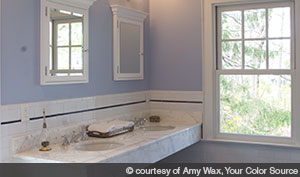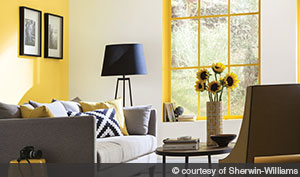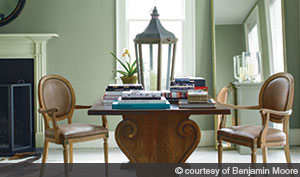Life was simpler when the choice of paint colors was more limited. Thousands of shades with catchy names now vie for attention, from “Knitting Needles” to “Dead Salmon.” Even deciding to use white can lead to the question of which one. Paint manufacturer Benjamin Moore offers more than 250 variations on that popular theme.
And that’s just the first part of the paint quandary. Once a color is applied to walls and dries, its hue may not resemble what’s on the paint chips (the sample, also known as strip chips or color cards, displayed at many paint, hardware, and big-box stores to guide shoppers). The reason for this variation can be anything from the lack of a primer to conceal the prior color, which can bleed through, to the amount of light in the room or the color of furnishings, both of which alter the look. Even the amount of sheen in the finish selected by home owners can make a big difference in the final appearance.
By heeding the five steps below, buyers and sellers can improve the odds of getting the colors they desire, which will save them time and money by avoiding the dreaded task of repainting.
1. Get inspired.
Some home owners know exactly which family of colors appeal to them; others have no clue. Sue Wadden, director of color marketing at paint manufacturer Sherwin-Williams, suggests real estate pros offer clients Pinterest boards or room photos in magazines and store catalogues like Pottery Barn, to help them decide. She also recommends looking at paint manufacturers’ annual color forecasts for fresh ideas.

A home owner’s next step is to pick up a handful of chips, strips, or cards—enough to have some variety but not too many to be confusing—that appeals to them. Next, they should tack them to the wall of the room to be painted, study them at different times of the day, and narrow the selection before buying and applying paint. Many of the larger manufacturers offer software home owners can use to upload a room photo and see how it might look in various hues. Color expert Amy Wax of Your Color Source in Montclair, N.J., cautions that some of these programs make paint colors appear brighter than they do once applied to walls. But they can be a starting point.
2. Test-drive possibilities.
Due to the variations in both color simulation programs and to the fact that paint colors may look different on a small chip versus a full wall, experts suggest applying the actual paint being considered in a small area as a test. This means ensuring everything in the tester is the same, down to the desired finish—matte, eggshell, semi-gloss, or high-gloss—since this will also influence the final color. Eggshell or satin, for instance, will darken the appearance of most colors and highlight wall imperfections, Wax says. Since the existing wall color will affect the new color’s appearance, Andrea Magno, a color and design expert with paint manufacturer Benjamin Moore, recommends covering an area first with primer and applying two coats of the paint, particularly if a light color is covering a dark one.

3. Factor in other surfaces.
Since ceiling and trim colors often vary from wall choices, paint manufacturers usually offer palette combinations that work well together. But the combinations do more than just add harmonious hues; they can fool the eye in its perception of the entire space. If a ceiling is painted a lighter tone than the surrounding walls, it may seem higher; if a darker color is used, it may look lower, Wax says. Using the same trim color in every room can become “an important thread of consistency throughout a home when rooms have been painted different colors,” Magno says. Typically, trim is painted in a glossier finish than walls to add a noticeable finishing touch to the room.

4. Bring a color pro onboard.
If your clients still feel unsure about making selections, suggest they hire a color or paint expert who’s used to working with different palettes, knows which color combinations work well together, and understands how colors create different spatial effects. Such consultants typically charge by the hour or project. Los Angeles–area interior designer Nicole Sassaman estimates a charge of around $1,500 for suggestions covering a six-room house. If your clients aren’t ready to take the plunge yet still need professional help, suggest they head to a paint manufacturer’s brick-and-mortar store. Many employ staff skilled at recommendations, often free of charge.
5. Consider the paint’s health effects.
Volatile organic compounds are chemicals that evaporate during and after the painting process and may impact indoor air quality, according to the Environmental Protection Agency and sources such as Berkeley Lab. VOCs can result in adverse health effects, especially for those with allergies or asthma.




